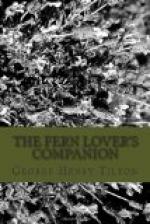Very fleshy, three to ten inches high, sterile segment subsessile, borne near the middle of the plant, oblong, simple pinnate with three to eight pairs of lunate or fan-shaped divisions, obtusely crenate, the veins repeatedly forking; fertile segment panicled, two to three pinnate.
[Illustration: Moonwort Botrychium Lunaria]
[Illustration: Moonwort. Botrychium Lunaria. Details]
The moonwort was formerly associated with many superstitions and was reputed to open all locks at a mere touch, and to unshoe all horses that trod upon it. “Unshoe the horse” was one of the names given to it by the country people.
“Horses that feeding on the grassy
hills,
Tread upon moonwort with their hollow
heels,
Though lately shod, at night go barefoot
home
Their maister musing where their shoes
be gone.”
In dry pastures, Lake Superior and northward, but rare in the United States. Willoughby, Vt., where the author found a single plant in 1904, and St. Johnsbury, Vt. Also New York, Michigan and westward.
In England said to be local rather than rare. Sometimes called Lunary.
“Then sprinkled she the juice of
rue
With nine drops of the midnight dew
From Lunary distilling.”
DRAYTON.
(2) LITTLE GRAPE FERN. Botrychium simplex
Fronds two to four inches high, very variable. Sterile segment short-petioled, usually near the middle, simple and roundish or pinnately three to seven lobed. Veins all forking from the base. Fertile segments simple or one to two pinnate, apex of both segments erect in the bud.
In moist woods and fields, Canada to Maryland and westward; Conway and Plainfield, Mass., Berlin and Litchfield, Conn. Rare. According to Pringle it is “abundantly scattered over Vermont, its habitat usually poor soil, especially knolls of hill pastures.” May or June.
(3) LANCE-LEAVED GRAPE FERN
Botrychium lanceolatum
BOTRYCHIUM ANGUSTISEGMENTUM
Frond two to nine inches high, both sterile and fertile segments at the top of the common stalk. Sterile segment triangular, twice pinnatifid, the acute lobes lanceolate, incised or toothed, scarcely fleshy, resembling a very small specimen of the rattlesnake fern. Fertile segment slightly overtopping the sterile, two to three pinnate and spreading.
One of the constant companions of the rattlesnake fern. New England to Lake Superior. July.
[Illustration: Little Grape Fern Botrychium simplex]
[Illustration: Lance-leaved Grape Fern Botrychium lanceolatum Botrychium angustisegmentum]
(4) MATRICARY FERN
Botrychium ramosum. Botrychium matricariaefolium
Fronds small, one to twelve inches high. Sterile segment above the middle, usually much divided. Fertile segment twice or thrice pinnate. Apex of both segments turned down in the bud, the sterile overtopping and clasping the fertile one.




